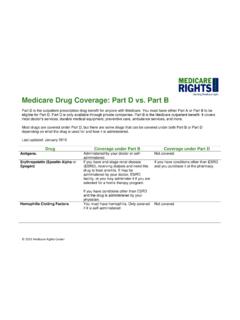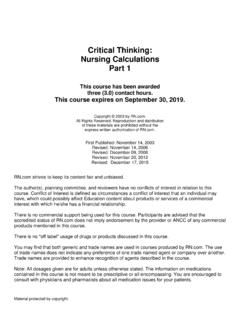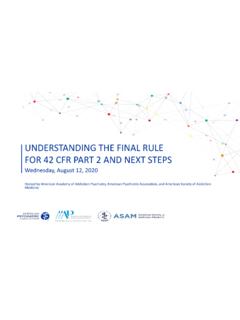Transcription of Part 107 Test Study Guide and Practice Exams - 3D Insider
1 12 INTRODUCTIONU nmanned Aerial Vehicles (UAVs), Small Unmanned Aerial Systems (sUAS) and drones are aircraft that have rapidly increased in popularity from being a hobby to a multimillion-dollar business. Almost every news station has drone operators with cameras to capture all manner of events and breaking news. Drones can also be used to inspect tall structures, aid in police operations, monitor events, survey property, advertise real estate, and much more.
2 Basic UAV operation is easy to learn, and many popular drone models are not terribly expensive, making this technology accessible to almost have inherent capabilities that were previously unavailable at such a huge scale and can be perceived to be improper or illegal ( , spying on neighbors) or hazardous (flying over crowds of people and stadiums). Moreover, just like any vehicle, drones can pose hazards to people and property if not safely operated and maintained.
3 As a result, the Federal Aviation Administration (FAA) has formulated rules that permit the commercial use of UAVs in a manner that is safe and does not endanger people, property, and other aircraft while allowing the widest possible use of this technology. The FAA does not apply this regulation to hobbyists or hobby UAVs, provided they are operated in the spirit of recreational activities. The FAA views UAVs in commercial operations as aircraft, their operators as pilots, and their operation subject to FAA oversight and regulations just as they are responsible for manned aircraft operators are regarded as pilots who are expected to understand the National Airspace System (NAS) in which UAVs are operated, and certain rules and regulations are implemented to ensure the safe operation of UAVs.
4 The key to this safe operation is the pilot operating the UAV. This individual is operating an aircraft in US airspace and is expected to follow a set of rules similar to those that apply to any pilot. This requires not only the ability to fly and maneuver the UAV competently, but also a certain level of knowledge on factors that affect the operation of UAVs. These factors include the different features of the NAS, safety, weather, coordination with local airports, air traffic control, potential hazards, and occasional emergencies.
5 As a result, the FAA promulgated the Small Unmanned Aircraft Regulations (sUAS) ( part 107 of the Federal Aviation Regulations), similar to Parts 61 and 91 that are applicable to manned : We have created this Guide to help you pass the part 107 Guide . We have spent hundreds of hours on this Guide and we have tried to make it accurate. However, it's your responsibility to keep up-to-date and verify the contents of this Guide before flying your of this Study Guide3 TABLE OF CONTENTSINTRODUCTIONCONTENTSKNOWLEDGE TEST DESCRIPTIONLIST OF RESOURCESGLOSSARY OF TERMS CHAPTER 1: APPLICABLE REGULATIONSCHAPTER 2: AIRSPACE CLASSIFICATION, OPERATING REQUIREMENTS, AND FLIGHT RESTRICTIONSCHAPTER 3: AVIATION WEATHER SOURCES SECTION 3A METEOROLOGICAL INFORMATION SOURCES AND UNDERSTANDING SUMMARY CHAPTER 3B.
6 EFFECTS OF WEATHER ON SMALL UNMANNED AIRCRAFT PERFORMANCE SUMMARYCHAPTER 4: SMALL UNMANNED AIRCRAFT LOADING CHAPTER 5: EMERGENCY PROCEDURES CHAPTER 6: CREW RESOURCE MANAGEMENT - DECISION -MAKING IN A DYNAMIC ENVIRONMENT CHAPTER 7: RADIO COMMUNICATION PROCEDURES 235691137586879808385904 CHAPTER 8: DETERMINING THE PERFORMANCE OF SMALL UNMANNED AIRCRAFT CHAPTER 9: PHYSIOLOGICAL FACTORS AFFECTING PILOT PERFORMANCE CHAPTER 10: MAINTENANCE AND PREFLIGHT INSPECTION PROCEDURESAPPENDIX 1 REGISTRATION AND MARKING REQUIREMENTS FOR SMALL UNMANNED AIRCRAFT APPENDIX 2 APPLICABLE REFERENCES 929397102102 Pass the part 107test the easy wayget $50 off part 107 courseOur readers can take advantage of an exclusive $50 off coupon code to the professional Pilot Institute part 107 course.
7 Save time and pass the test with + Easy to Follow Video Lectures2 Practice TestsGuaranteed You Pass or Your Test Fee is Free5 KNOWLEDGE TEST DESCRIPTIONA key aspect of part 107 for commercial UAV pilots is the requirement to demonstrate suffi-cient knowledge to operate a UAV safely and in accordance with applicable Federal Aviation Regulations (FARs). To demonstrate the necessary knowledge, a UAV operator must either have a current pilot s certificate (including a biennial review) or pass an FAA knowledge test to qualify as a UAV Pilot-in-Command and obtain a Remote Pilot Certificate with a small Unmanned Aircraft System (sUAS) rating.
8 Note: the term pilot in this Study Guide refers to or includes operators of unmanned aircraft unless it is defined by a specific pilot role or rating such as private pilot or airline certification knowledge test consists of objective, multiple-choice questions. There is a single correct response for each test question. Each test question is independent of other questions. A correct response to one question does not depend upon, or influence, the correct response to another.
9 The knowledge test applicant has up to two hours to complete the OF RESOURCESThis is a Study Guide , not a textbook. The information needed to successfully pass the FAA test for the Remote Pilot Certificate is contained in the following documents:FAR part 107 In Effect since August 29, 2016 (or Latest Revision): This regulation defines the requirements to become an sUAS certified pilot. It does NOT contain all of the information needed to pass the required electronic: Pilot Small Unmanned Aircraft Systems (Certification and Recurrent Knowledge Testing) - Airman Certification Standards FAA-S-ACS-10A (June 2018 or most recent version) 107-2 - Small Unmanned Aircraft Systems (sUAS) 60-22 - Aeronautical Decision Making FAA Information Manual (AIM) Charts (Hardcopy): ) or Aeronautical Charts (Digital).
10 (You will be required to demonstrate the ability to in-terpret symbols and information on Aeronautical Charts).Pilot/Controller Glossary: s Handbook of Aeronautical Knowledge: pilot handbookGeneral Aviation Pilot s Guide to Preflight Weather Planning, Weather Self-Briefings, and Weather Decision Making: \Risk Management Handbook: Knowledge Testing (AKT) Centers: of these documents are available online free to download. You may, however, want to purchase copies of the Aeronautical Information Manual and copies of Sectional Charts for the areas in which you expect to operate an sUAS.






